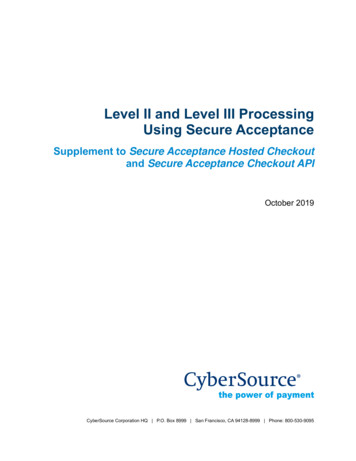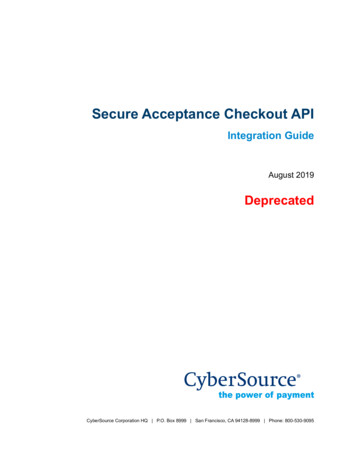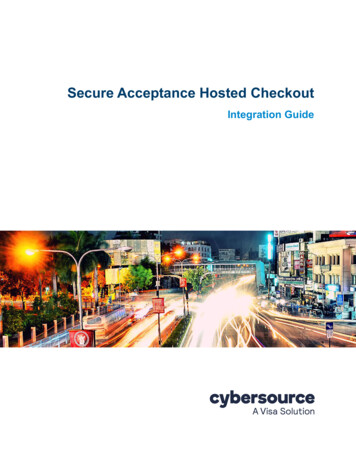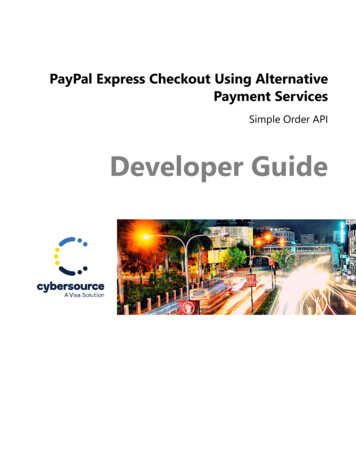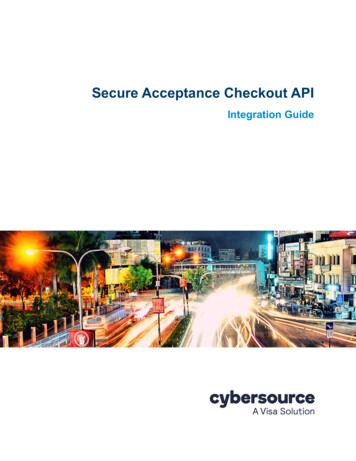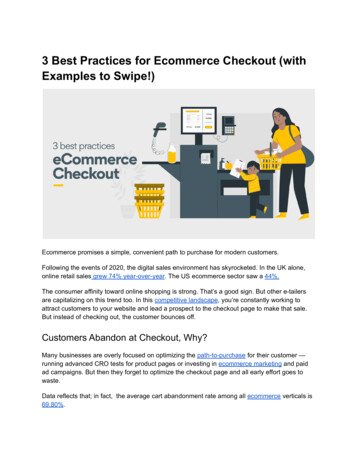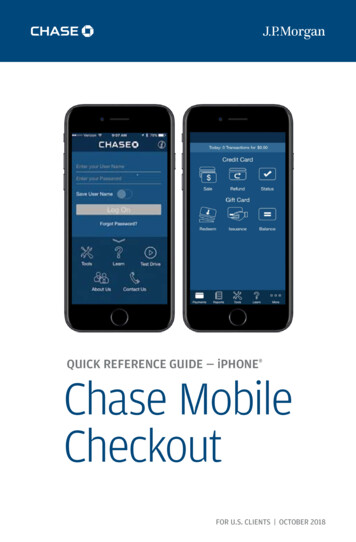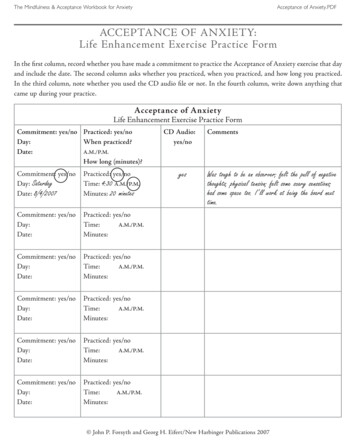
Transcription
Title PageSecure Acceptance Hosted CheckoutIntegration GuideAugust 2019DeprecatedCyberSource Corporation HQ P.O. Box 8999 San Francisco, CA 94128-8999 Phone: 800-530-9095
CyberSource Contact InformationFor general information about our company, products, and services, go tohttp://www.cybersource.com.For sales questions about any CyberSource Service, email sales@cybersource.com orcall 650-432-7350 or 888-330-2300 (toll free in the United States).For support information about any CyberSource Service, visit the Support Center:http://www.cybersource.com/supportCopyright 2019 CyberSource Corporation. All rights reserved. CyberSource Corporation ("CyberSource") furnishes thisdocument and the software described in this document under the applicable agreement between the reader ofthis document ("You") and CyberSource ("Agreement"). You may use this document and/or software only inaccordance with the terms of the Agreement. Except as expressly set forth in the Agreement, the informationcontained in this document is subject to change without notice and therefore should not be interpreted in any wayas a guarantee or warranty by CyberSource. CyberSource assumes no responsibility or liability for any errorsthat may appear in this document. The copyrighted software that accompanies this document is licensed to Youfor use only in strict accordance with the Agreement. You should read the Agreement carefully before using thesoftware. Except as permitted by the Agreement, You may not reproduce any part of this document, store thisdocument in a retrieval system, or transmit this document, in any form or by any means, electronic, mechanical,recording, or otherwise, without the prior written consent of CyberSource.Restricted Rights LegendsFor Government or defense agencies. Use, duplication, or disclosure by the Government or defense agenciesis subject to restrictions as set forth the Rights in Technical Data and Computer Software clause at DFARS252.227-7013 and in similar clauses in the FAR and NASA FAR Supplement.For civilian agencies. Use, reproduction, or disclosure is subject to restrictions set forth in subparagraphs (a)through (d) of the Commercial Computer Software Restricted Rights clause at 52.227-19 and the limitations setforth in CyberSource Corporation's standard commercial agreement for this software. Unpublished rightsreserved under the copyright laws of the United States.TrademarksAuthorize.Net, eCheck.Net, and The Power of Payment are registered trademarks of CyberSource Corporation.CyberSource, CyberSource Payment Manager, CyberSource Risk Manager, CyberSource Decision Manager,and CyberSource Connect are trademarks and/or service marks of CyberSource Corporation.All other brands and product names are trademarks or registered trademarks of their respective owners.2
CONTENTSContentsRecent Revisions to This DocumentAbout This Guide68Audience and PurposeWeb Site Requirements88Conventions 9Note, Important, and Warning StatementsText and Command Conventions 9Related DocumentsCustomer SupportChapter 191011Using Secure Acceptance Hosted CheckoutRequired Browsers1213Secure Acceptance Profile13Secure Acceptance Transaction Flow14Payment Tokens 15Tokens That Represent a Card or Bank Account Onlyone-click Checkout16Subscription PaymentsLevel II and III Data1617BIN Lookup 17Requirement 18Requesting BIN LookupPayouts1818Go-Live with Secure AcceptanceChapter 21619Creating a Hosted Checkout ProfileConfiguring Payment Methods 21Adding a Card Type 21Enabling Payer AuthenticationSecure Acceptance Hosted Checkout Integration Guide August 201920223
ContentsAdding a Currency 24Enabling Automatic Authorization ReversalsEnabling eChecks 25Enabling Visa Checkout 26Enabling PayPal Express Checkout 27Enabling the Service Fee 28Creating a Security Key2429Configuring Checkout 31Configuring the Checkout Flow 31Displaying the Tax Amount 32Displaying Billing Information Fields 33Displaying Shipping Information Fields 34Displaying eCheck Information Fields 35Customizing Order Review Details 36Receiving Merchant Notifications36Sending a Customer Receipt 38Customer Notification Details 38Company Logo 39Custom Email Receipt 39Displaying a Response Page 40Transaction Response Page 40CyberSource Hosted Response PageCustom Hosted Response Page 41Cancel Response Page 41CyberSource Hosted Response PageCustom Cancel Response Page 42Customizing the Checkout AppearanceLocalizing the Checkout LanguagesActivating a Profile 48Additional Options for a Profile41424648Samples in Scripting Languages 48Sample Transaction Process Using JSPChapter 3Updating a Secure Acceptance ProfileChapter 4Processing Transactions495052Endpoints and Transaction TypesRequired Signed Fields405253Creating a Payment TokenPayment Card 54eCheck 5754Secure Acceptance Hosted Checkout Integration Guide August 20194
ContentsPayment Token TransactionOne-Click 59eCheck 61Recurring Payments5963Installment Payments65Updating a Payment TokenPayment Card 67eCheck 6967Chapter 5Using Decision ManagerChapter 6Testing and Viewing TransactionsTesting Transactions717373Viewing Transactions in the Business CenterAppendix A API Fields7476Data Type DefinitionsRequest FieldsReply Fields7677115Reason Codes151Types of Notifications154AVS Codes 155International AVS Codes 155U.S. Domestic AVS Codes 156CVN Codes158Appendix B American Express SafeKey Response CodesAppendix C Iframe ImplementationClickjacking PreventionEndpoints159160161161Appendix D Visa Secure Response Codes162Secure Acceptance Hosted Checkout Integration Guide August 20195
ReleaseChangesAugust 2019Deprecated this guide because it contains procedures for the Classic Business Center. Forprocedures in the New Business Center, see Secure Acceptance Hosted Checkout IntegrationGuide (PDF HTML).REVISIONSRecent Revisions to ThisDocumentAdded required browsers. See "Required Browsers," page 13.Updated the description for the reason code reply field. See reason code, page 133.Added an important note about iframes. See Appendix C, "Iframe Implementation," onpage 160.July 2019Updated transaction flow. See "Secure Acceptance Transaction Flow," page 14.Added list of required signed fields. See "Required Signed Fields," page 53.Added the override customer utc offset request field. See override customer utc offset,page 100.Updated the payment method field. See payment method, page 103.June 2019Changed the name of Mastercard SecureCode to Mastercard Identity Check.Changed the name of Verified by Visa to Visa Secure.Secure Acceptance Hosted Checkout Integration Guide August 20196
Recent Revisions to This DocumentReleaseChangesMay 2019Updated information about payer authentication. See "Enabling Payer Authentication,"page 22.Added the following payer authentication request fields for 3D Secure. See "Request Fields,"page 77. payer authentication challenge code payer authentication customer daily transaction count payer authentication customer annual transaction count payer authentication marketing source payer authentication mobile phone payer authentication new customer payer authentication pre order payer authentication pre order date payer authentication recurring end date payer authentication recurring frequency payer authentication reorder payer authentication ship to address first used payer authentication transaction modeUpdated the following request fields. See "Request Fields," page 77.bill to address state submerchant state Added the following payer authentication reply fields for 3D Secure. See "Reply Fields,"page 115. auth cavv result auth cavv result raw payer authentication specification version payer authentication transaction idUpdated the following reply fields. See "Reply Fields," page 115. payer authentication proof xml req bill to address state req submerchant stateAdded Appendix B, "American Express SafeKey Response Codes," on page 159 andAppendix D, "Visa Secure Response Codes," on page 162.February 2019Updated the reply field bill trans ref no. See bill trans ref no, page 119.December 2018Added information about TMS and third-party tokens. See "Tokens That Represent a Card orBank Account Only," page 16.Updated an Important note. See "Company Logo," page 39.Updated the permitted characters for the ASCIIAlphaNumericPunctuation data type. See"Data Type Definitions," page 76.Updated the description for the auth trans ref no reply field. See auth trans ref no,page 119.Secure Acceptance Hosted Checkout Integration Guide August 20197
ABOUT GUIDEAbout This GuideAudience and PurposeThis guide is written for merchants who want to accept payments using SecureAcceptance Hosted Checkout and who do not want to handle or store sensitive paymentinformation on their own servers.Using Secure Acceptance Hosted Checkout requires minimal scripting skills. You mustcreate a security script and modify your HTML form to invoke Secure Acceptance. You willalso use the Business Center to review and manage orders.Web Site RequirementsYour web site must meet the following requirements: It must have a shopping-cart, customer order creation software, or an application forinitiating disbursements to send funds to payment accounts. It must contain product pages in one of the supported scripting languages. See"Sample Transaction Process Using JSP," page 49. The IT infrastructure must be Public Key Infrastructure (PKI) enabled to useSSL-based form POST submissions. The IT infrastructure must be capable of digitally signing customer data prior tosubmission to Secure Acceptance Hosted Checkout.Secure Acceptance Hosted Checkout Integration Guide August 20198
About This GuideConventionsNote, Important, and Warning StatementsA Note contains helpful suggestions or references to material not contained inthe document.NoteAn Important statement contains information essential to successfullycompleting a task or learning a concept.ImportantWarningA Warning contains information or instructions, which, if not heeded, can resultin a security risk, irreversible loss of data, or significant cost in time or revenueor both.Text and Command ConventionsConventionUsageBold Field and service names in text; for example:Include the transaction type field. Items that you are instructed to act upon; for example:Click Save.Screen text Code examples and samples. Text that you enter in an API environment; for example:Set the transaction type field to create paymenttoken.Secure Acceptance Hosted Checkout Integration Guide August 20199
About This GuideRelated DocumentsRefer to the Support Center for complete CyberSource technical documentation:http://www.cybersource.com/support center/support documentationTable 1Related DocumentsSubjectDescriptionBusiness CenterBusiness Center User Guide—describes how to use the New BusinessCenter.DecisionManagerThe following documents describe how to integrate and use the DecisionManager services.Electronic checks Decision Manager Using the SCMP API Developer Guide (PDF HTML) Decision Manager Using the Simple Order API Developer Guide (PDF HTML)The following documents describe how to integrate and use the electroniccheck services: Electronic Check Services Using the SCMP API (PDF HTML) Electronic Check Services Using the Simple Order API (PDF HTML)Level II andLevel IIILevel II and Level III Processing Using Secure Acceptance (PDF HTML)—describes each Level II and Level III field and processing Level II and LevelIII transactions using Secure Acceptance.PayerAuthenticationThe following documents describe how to integrate and use the payerauthentication services:Payment cards Payer Authentication Using the SCMP API (PDF HTML) Payer Authentication Using the Simple Order API (PDF HTML)The following documents describe how to integrate payment cardprocessing into an order management system: Credit Card Services Using the SCMP API (PDF HTML) Credit Card Services Using the Simple Order API (PDF HTML)Payment securitystandardsPayment Card Industry Data Security Standard (PCI DSS)—web site offersstandards and supporting materials to enhance payment card data security.PayoutsThe following documents describe how to integrate and use the Payoutsfunctionality:PayPal ExpressCheckout Payouts Using the SCMP API (PDF HTML) Payouts Using the Simple Order API (PDF HTML)The following documents describe how to integrate and use the PayPalExpress Checkout services: PayPal Express Checkout Services Using the SCMP API (PDF HTML) PayPal Express Checkout Services Using the Simple Order API (PDF HTML).Secure Acceptance Hosted Checkout Integration Guide August 201910
About This GuideTable 1Related Documents (Continued)SubjectDescriptionRecurring BillingThe following documents describe how to create customer subscriptionsand use payment tokens for recurring and installment payments: Recurring Billing Using the Business Center (PDF HTML) Recurring Billing Using the SCMP API (PDF HTML) Recurring Billing Using the Simple Order API (PDF HTML)ReportingBusiness Center Reporting User Guide—describes how to view andconfigure custom reports using the New Business Center.SecureAcceptanceThe following documents describe how to integrate and use the SecureAcceptance Checkout API, along with processing a transaction with theservice fee sa Checkout Secure Acceptance Checkout API Integration Guide (PDF HTML) Secure Acceptance Checkout API Service Fee Guide (PDF)The following documents describe how to create tokens with a third-partyprovider and are available from CyberSource Customer Support: Tokenization with a Third-Party Provider Using the SCMP API Tokenization with a Third-Party Provider Using the Simple Order APIThe following documents describe how to integrate and use the tokenmanagement service: Token Management Service Using the SCMP API (PDF HTML) Token Management Service Using the Simple Order API (PDF HTML)Getting Started with Visa Checkout (PDF HTML)—describes how to enrollin Visa Checkout and create a Visa Checkout profile.Customer SupportFor support information about any CyberSource service, visit the Support Center:http://www.cybersource.com/supportSecure Acceptance Hosted Checkout Integration Guide August 201911
CHAPTERUsing Secure AcceptanceHosted Checkout1Secure Acceptance Hosted Checkout was previously called SecureAcceptance Web/Mobile.NoteCyberSource Secure Acceptance Hosted Checkout is your secure hosted customercheckout experience. It consists of securely managed payment forms or as a single pagepayment form for capturing payment card data, processing transactions, enabling you todecrease your Payment Card Industry Data Security Standard (PCI DSS) obligations andthereby reducing any risks associated with handling or storing sensitive paymentinformation. You, the merchant, out-source capturing and managing payment card data toSecure Acceptance, which is designed to accept card payments.WarningSecure Acceptance is designed to process transaction requests directly fromthe customer browser so that sensitive payment data does not pass throughyour servers. If you do intend to send payment data from your servers, use theSOAP Toolkit API or the Simple Order API. Sending server-side paymentsusing Secure Acceptance incurs unnecessary overhead and could result in thesuspension of your merchant account and subsequent failure of transactions.To create your customer’s Secure Acceptance experience, you take these steps:1Create and configure Secure Acceptance profiles.2Update the code on your web site to render the Secure Acceptance Hosted Checkout andimmediately process card transactions (see "Samples in Scripting Languages," page 48).Sensitive card data bypasses your network and is accepted by Secure Acceptancedirectly from the customer. CyberSource processes the transaction on your behalf bysending an approval request to your payment processor in real time. See "SecureAcceptance Transaction Flow," page 14.3Use the reply information to display an appropriate transaction response page to thecustomer. You can view and manage all orders in the Business Center (see "ViewingTransactions in the Business Center," page 74).Secure Acceptance Hosted Checkout Integration Guide August 201912
Chapter 1Using Secure Acceptance Hosted CheckoutRequired BrowsersThe following browsers are required to ensure the Secure Acceptance checkout flow isfast and secure:Desktop browsers: IE 10 or later Edge 13 or later Firefox 42 or later Chrome 48 or later Safari 7.1 or later Opera 37 or laterMobile browsers: iOS Safari 7.1 or later Android Browser 4.4 or later Chrome Mobile 48 or laterSecure Acceptance ProfileA Secure Acceptance profile consists of settings that you configure to create a customercheckout experience. You can create and edit multiple profiles, each offering a customcheckout experience (see "Customizing the Checkout Appearance," page 42). Forexample, you might need multiple profiles for localized branding of your web sites.You candisplay a multi-step checkout process or a single page checkout (see "ConfiguringCheckout," page 31) to the customer as well as configure the appearance and branding,payment options, languages, and customer notifications.Secure Acceptance Hosted Checkout Integration Guide August 201913
Chapter 1Using Secure Acceptance Hosted CheckoutSecure Acceptance Transaction FlowThe Secure Acceptance Hosted Checkout transaction flow is illustrated in Figure 1 anddescribed below.Figure 11Secure Acceptance Hosted Checkout Transaction FlowThe customer clicks the Pay button on your web site, which triggers an HTTPS POST thatdirects the customer to the hosted Secure Acceptance Hosted Checkout page that youconfigured in the Business Center (see Chapter 2, "Creating a Hosted Checkout Profile,"on page 20). The HTTPS POST includes the signature and signed data fields containingthe order information.Secure Acceptance Hosted Checkout works best with JavaScript and cookiesenabled in the customer browser.NoteWarning2Your system should sign only Secure Acceptance request fields. To preventmalicious actors from impersonating CyberSource, do not allow unauthorizedaccess to the signing function.Secure Acceptance verifies the signature to ensure that the order details were notamended or tampered with and displays the Secure Acceptance Hosted Checkout page.The customer enters and submits payment details and/or their billing and shippinginformation. The customer confirms the payment, and the transaction is processed.Secure Acceptance Hosted Checkout Integration Guide August 201914
Chapter 13Using Secure Acceptance Hosted CheckoutCyberSource recommends that you configure a custom receipt page in the BusinessCenter (see "Receiving Merchant Notifications," page 36) so that the signed transactionresponse is posted back to your merchant server through the browser. You must validatethe reply signature to confirm that the reply data was not amended or tampered with.Secure Acceptance can also display a standard receipt page to your customer, and youcan verify the result of the transaction using the Business Center search or the standardCyberSource reports.If the reply signature in the reply field does not match the signature calculatedbased on the reply data, treat the POST as malicious and disregard it.Warning4Secure Acceptance signs every response field. Ignore any reply fields in thePOST that are not in the signed fields field.CyberSource recommends implementing the merchant POST URL notification (see"Receiving Merchant Notifications," page 36) as a backup means of determining thetransaction result. This method does not rely on your customer’s browser. You receive thetransaction result even if your customer lost connection after confirming the payment.If the transaction type is sale, it is immediately submitted for settlement. If the transactiontype is authorization, use the CyberSource Simple Order API to submit a capture requestwhen goods are shipped.Payment TokensImportantContact CyberSource Customer Support to activate your merchant account forthe use of the payment tokenization services. You cannot use paymenttokenization services until your account is activated and you have enabledpayment tokenization for Secure Acceptance (see "Creating a HostedCheckout Profile," page 20).Payment tokens are unique identifiers that replace sensitive payment information and thatcannot be mathematically reversed. CyberSource securely stores all the card information,replacing it with the payment token. The token is also known as a subscription ID, whichyou store on your server.The payment tokenization solution is compatible with the Visa and Mastercard AccountUpdater service. Card data stored with CyberSource is automatically updated byparticipating banks, thereby reducing payment failures. See the Account Updater UserGuide (PDF HTML).The payment token replaces the card or electronic check bank account number, andoptionally the associated billing, shipping, and card information. No sensitive cardinformation is stored on your servers, thereby reducing your PCI DSS obligations.For more information about tokens, see "Related Documents," page 10.Secure Acceptance Hosted Checkout Integration Guide August 201915
Chapter 1Using Secure Acceptance Hosted CheckoutTokens That Represent a Card or Bank Account OnlyInstrument identifier tokens created using the Token Management Service (TMS) andthird-party tokens represent a payment card number or bank account number. The samecard number or bank account number sent in multiple token creation calls results in thesame payment token being returned. TMS instrument identifier and third-party tokenscannot be updated. If your merchant account is configured for one of these token types,you receive an error if you attempt to update a token.When using Secure Acceptance with tokens that represent only the card number or bankaccount, you must include associated data, such as expiration dates and billing addressdata, in your transaction request.one-click CheckoutWith one-click Checkout, customers can buy products with a single click. SecureAcceptance is integrated to CyberSource Tokenization, so returning customers are notrequired to enter their payment details. Before a customer can use one-click Checkout,they must create a payment token during the first transaction on the merchant web site.See "Payment Token Transaction," page 59. The payment token is an identifier for thepayment details; therefore, no further purchases require that you enter any information.When the payment token is included in a payment request, it retrieves the card, billing,and shipping information related to the original payment request from the CyberSourcedatabase.To use one-click Checkout, you must include the one-click Checkout endpoint to processthe transaction. See "Endpoints and Transaction Types," page 52.Subscription PaymentsA customer subscription contains information that you store in the CyberSource databaseand use for future billing. At any time, you can send a request to bill the customer for anamount you specify, and CyberSource uses the payment token to retrieve the card, billing,and shipping information to process the transaction. You can also view the customersubscription in the CyberSource Business Center. See "Viewing Transactions in theBusiness Center," page 74.A customer subscription includes: Customer contact information, such as billing and shipping information. Customer payment information, such as card type, masked account number, andexpiration date.Secure Acceptance Hosted Checkout Integration Guide August 201916
Chapter 1 Using Secure Acceptance Hosted CheckoutCustomer order information, such as the transaction reference number and merchantdefined data fields.Table 2Types of SubscriptionsType of SubscriptionDescriptionRecurringA recurring billing service with no specific end date. You must specifythe amount and frequency of each payment and the start date forprocessing the payments. CyberSource creates a schedule based onthis information and automatically bills the customer according to theschedule. For example, you can offer an online service that thecustomer subscribes to and can charge a monthly fee for thisservice. See "Recurring Payments," page 63.InstallmentA recurring billing service with a fixed number of scheduledpayments. You must specify the number of payments, the amountand frequency of each payment, and the start date for processing thepayments. CyberSource creates a schedule based on thisinformation and automatically bills the customer according to theschedule. For example, you can offer a product for 75.00 and let thecustomer pay in three installments of 25.00. See "InstallmentPayments," page 65.Level II and III DataSecure Acceptance supports Level II and III data. Level II cards, also know as Type IIcards, provide customers with additional information on their payment card statements.Business/corporate cards along with purchase/procurement cards are considered Level IIcards.Level III data can be provided for purchase cards, which are payment cards used byemployees to make purchases for their company. You provide additional detailedinformation—the Level III data—about the purchase card order during the settlementprocess. The Level III data is forwarded to the company that made the purchase, and itenables the company to manage its purchasing activities.For detailed descriptions of each Level II and Level III field, see Level II and Level IIIProcessing Using Secure Acceptance (PDF HTML). This guide also describes how torequest sale and capture transactions.BIN LookupThe bank identification number (BIN) lookup service provides information about apayment card account based on first six digits of the account number. The informationprovided can be the country in which the card was issued, the domestic currency, andwhether the card qualifies for the Payouts service. See "Payouts," page 18.Secure Acceptance Hosted Checkout Integration Guide August 201917
Chapter 1Using Secure Acceptance Hosted CheckoutRequirementTo enable BIN lookup, contact CyberSource Customer Support to have your accountconfigured for this feature.Requesting BIN LookupYou can request the BIN Lookup service with Secure Acceptance in the General Settingsof your Secure Acceptance profile in the Business Center. You can set the BIN Lookupservice to one of two modes: Free: verifies that the card is eligible for sending funds through the Payouts service. Paid: premium service that returns all data available for the BIN.The BIN Lookup response is sent to the merchant notifications URL and email. See"Receiving Merchant Notifications," page 36. For security reasons it is not sent to thereceipt URL.The BIN Lookup results are detailed in the reply fields with the bin lookup prefix. SeeAppendix A, "Reply Fields," on page 115.PayoutsUse Secure Acceptance to create a payment token that can be used with the Payouts APIor batch submissions.To create a payment token for Payouts:Step 1Create a Secure Acceptance Profile and define your checkout page. See Chapter 2,"Creating a Hosted Checkout Profile," on page 20.Step 2Enable BIN Lookup to verify that the card used is eligible for sending funds using thePayouts service. See "BIN Lookup," page 17.Step 3For transaction processing, create a payment token. See "Creating a Payment Token,"page 54.Step 4Set the Payouts subscription ID field to the value of the payment token.See Payouts Using the Simple Order API (PDF HTML) or Payouts Using the SCMP API(PDF HTML).Secure Acceptance Hosted Checkout Integration Guide August 201918
Chapter 1Using Secure Acceptance Hosted CheckoutGo-Live with Secure AcceptanceImportantCyberSource recommends that you submit all banking information andrequired integration services in advance of going live. Doing so will speed upyour merchant account configuration.When you are ready to implement Secure Acceptance in your live environment, you mustcontact CyberSource Customer Support and request Go-Live. When all the bankinginformation has been received by CyberSource the Go-Live procedure can require threedays to complete. No Go-Live implementations take place on a Friday.Secure Acceptance Hosted Checkout Integration Guide August 201919
ImportantCHAPTERCreating a Hosted CheckoutProfile2Contact CyberSource Customer Support to enable your account for SecureAcceptance. You must activate a profile in order to use it (see "Activating aProfile," page 48).To create a Hosted Checkout profile:Step 1Log in to the Business Center: Live transactions: https://ebc.cybersource.com Test transactions: https://ebctest.cybersource.comStep 2In the left navigation panel, choose Tools & Settings Secure Acceptance Profiles.Step 3Enter or verify the following profile details.Table 3Profile DetailsProfile DetailDescriptionProfile NameThe Secure Acceptance profile name is required and cannot exceed20 alphanumeric characters.DescriptionThe profile description cannot exceed 255 characters.Integration MethodCheck Web/Mobile.Company NameThe company name is required and cannot exceed 40 alphanumericcharacters.Company Contact NameEnter company contact information: name, email, and phonenumber.Company Contact EmailCompany Phone NumberPayment TokenizationCheck Payment Tokenization. For more information, seeChapter 4, "Processing Transactions," on page 52.Decision ManagerCheck Decision Manager. For more information, see Chapter 5,"Using Decision Manager," on page 71.Enable Verbose DataCheck Enable Verbose Data. For more information, see Chapter 5,"Using Decision Manager," on page 71.Generate DeviceFingerprintCheck Generate Device Fingerprint. For more information, seeChapter 5, "Using Decision Manager," on page 71.Secure Acceptance Hosted Checkout Integration Guide August 201920
Chapter 2Step 4Creating a Hosted Checkout ProfileClick Create. The Configuring Payment Settings page appe
Using Secure Acceptance Hosted Checkout requires minimal scripting skills. You must create a security script and modify your HTML form to invoke Secure Acceptance. You will also use the Business Center to review and manage orders. Web Site Requirements Your web site must meet the following requirements:
